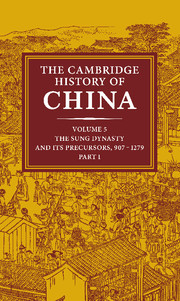Book contents
- Frontmatter
- Introduction: the Sung Dynasty and Its Precursors, 907–1279
- 1 The Five Dynasties
- 2 The Southern Kingdoms between the T’ang and the Sung, 907–979
- 3 Founding and Consolidation of the Sung Dynasty under T’ai-tsu (960–976), T’ai-tsung (976–997), and Chen-tsung (997–1022)
- 4 The Reigns of Jen-tsung (1022–1063) and Ying-tsung (1063–1067)
- 5 Shen-tsung’s Reign and the New Policies of Wang An-shih, 1067–1085
- 6 Che-tsung’s Reign (1085–1100) and the Age of Faction
- 7 The Reigns of Hui-tsung (1100–1126) and Ch’in-tsung (1126–1127) and the Fall of the Northern Sung
- 8 The Move to the South and the Reign of Kao-tsung (1127–1162)
- 9 The Reign of Hsiao-tsung (1162–1189)
- 10 The Reigns of Kuang-tsung (1189–1194) and Ning-tsung (1194–1224)
- 11 The Reign of Li-tsung (1224–1264)
- 12 The Reign of Tu-tsung (1264–1274) and His Successors to 1279
- Bibliography
- Glossary–Index
- References
3 - Founding and Consolidation of the Sung Dynasty under T’ai-tsu (960–976), T’ai-tsung (976–997), and Chen-tsung (997–1022)
Published online by Cambridge University Press: 28 March 2010
- Frontmatter
- Introduction: the Sung Dynasty and Its Precursors, 907–1279
- 1 The Five Dynasties
- 2 The Southern Kingdoms between the T’ang and the Sung, 907–979
- 3 Founding and Consolidation of the Sung Dynasty under T’ai-tsu (960–976), T’ai-tsung (976–997), and Chen-tsung (997–1022)
- 4 The Reigns of Jen-tsung (1022–1063) and Ying-tsung (1063–1067)
- 5 Shen-tsung’s Reign and the New Policies of Wang An-shih, 1067–1085
- 6 Che-tsung’s Reign (1085–1100) and the Age of Faction
- 7 The Reigns of Hui-tsung (1100–1126) and Ch’in-tsung (1126–1127) and the Fall of the Northern Sung
- 8 The Move to the South and the Reign of Kao-tsung (1127–1162)
- 9 The Reign of Hsiao-tsung (1162–1189)
- 10 The Reigns of Kuang-tsung (1189–1194) and Ning-tsung (1194–1224)
- 11 The Reign of Li-tsung (1224–1264)
- 12 The Reign of Tu-tsung (1264–1274) and His Successors to 1279
- Bibliography
- Glossary–Index
- References
Summary
t’ai-tsu and the founding of the sung, 960–976
The last years of the Five Dynasties era
The end of T’ang imperial rule in 907 resulted in seventy-two years of political division, the emergence of nine kingdoms in the south, the Sha-T’o-ruled kingdom of Northern Han (951–79) (in Shansi), and a succession of five short-lived dynasties located in the traditional center of the Chinese imperium in the Yellow River valley. While the southern kingdoms (891–979) lasted for decades in relative peace and prosperity, the north was in a constant state of war, and each of the so-called Five Dynasties (907–60) rapidly supplanted one another through regicides, army mutinies, and war. This political fragmentation and instability invited military incursions and sometimes drew into the region armies of the Sha-T’o Turks and Khitan (Ch’i-tan). Further west, in the region of Kansu, former T’ang territories were controlled by Tibetan, Uighur, and Tangut warlord states. The most successful of these frontier groups were the Khitan, who incorporated the Sixteen Prefectures (a region encompassing modern Peking) into their own Liao empire (907–1125).
The decline of administrative order in the late T’ang dynasty gave rise to widespread banditry and separatist regional military governors (chieh-tu shih). The notorious Chu Wen (r. 907–12), for example, deserted the Huang Ch’ao rebellion (875–84) to become a T’ang military governor, then murdered and deposed the last two T’ang emperors to found his own Later Liang dynasty, which lasted sixteen years (907–23), the longest of the northern dynasties.
- Type
- Chapter
- Information
- The Cambridge History of China , pp. 206 - 278Publisher: Cambridge University PressPrint publication year: 2009
References
- 1
- Cited by



